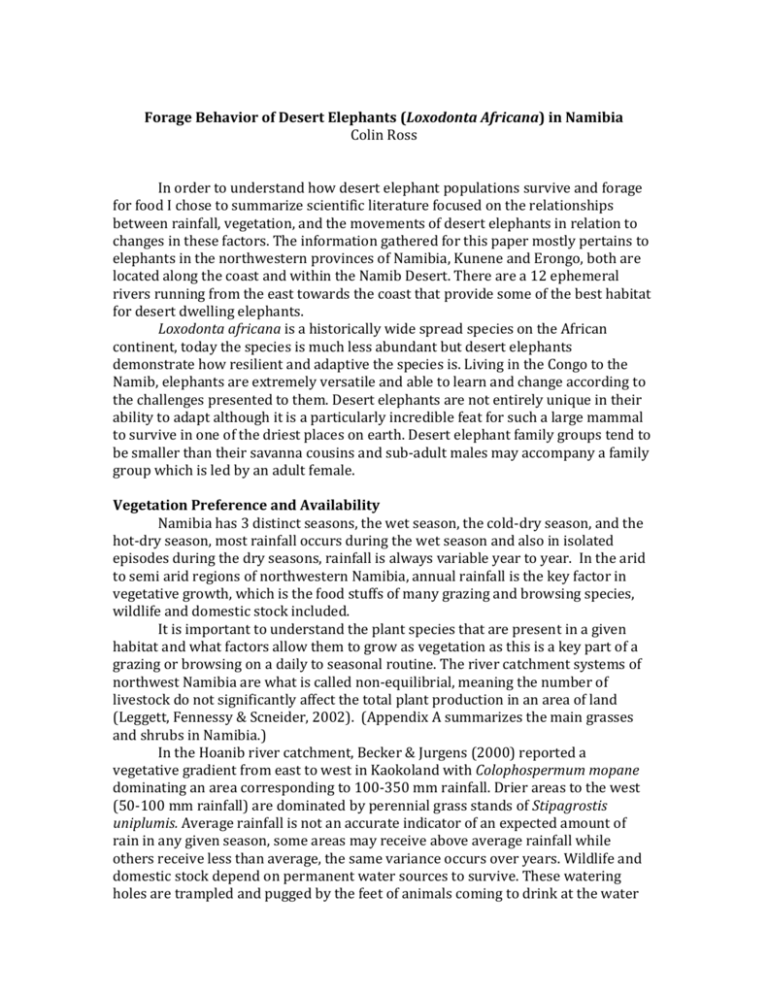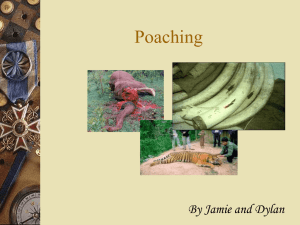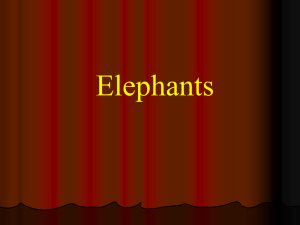Forage Behavior of Desert Elephants in Namibia
advertisement

Forage Behavior of Desert Elephants (Loxodonta Africana) in Namibia Colin Ross In order to understand how desert elephant populations survive and forage for food I chose to summarize scientific literature focused on the relationships between rainfall, vegetation, and the movements of desert elephants in relation to changes in these factors. The information gathered for this paper mostly pertains to elephants in the northwestern provinces of Namibia, Kunene and Erongo, both are located along the coast and within the Namib Desert. There are a 12 ephemeral rivers running from the east towards the coast that provide some of the best habitat for desert dwelling elephants. Loxodonta africana is a historically wide spread species on the African continent, today the species is much less abundant but desert elephants demonstrate how resilient and adaptive the species is. Living in the Congo to the Namib, elephants are extremely versatile and able to learn and change according to the challenges presented to them. Desert elephants are not entirely unique in their ability to adapt although it is a particularly incredible feat for such a large mammal to survive in one of the driest places on earth. Desert elephant family groups tend to be smaller than their savanna cousins and sub-adult males may accompany a family group which is led by an adult female. Vegetation Preference and Availability Namibia has 3 distinct seasons, the wet season, the cold-dry season, and the hot-dry season, most rainfall occurs during the wet season and also in isolated episodes during the dry seasons, rainfall is always variable year to year. In the arid to semi arid regions of northwestern Namibia, annual rainfall is the key factor in vegetative growth, which is the food stuffs of many grazing and browsing species, wildlife and domestic stock included. It is important to understand the plant species that are present in a given habitat and what factors allow them to grow as vegetation as this is a key part of a grazing or browsing on a daily to seasonal routine. The river catchment systems of northwest Namibia are what is called non-equilibrial, meaning the number of livestock do not significantly affect the total plant production in an area of land (Leggett, Fennessy & Scneider, 2002). (Appendix A summarizes the main grasses and shrubs in Namibia.) In the Hoanib river catchment, Becker & Jurgens (2000) reported a vegetative gradient from east to west in Kaokoland with Colophospermum mopane dominating an area corresponding to 100-350 mm rainfall. Drier areas to the west (50-100 mm rainfall) are dominated by perennial grass stands of Stipagrostis uniplumis. Average rainfall is not an accurate indicator of an expected amount of rain in any given season, some areas may receive above average rainfall while others receive less than average, the same variance occurs over years. Wildlife and domestic stock depend on permanent water sources to survive. These watering holes are trampled and pugged by the feet of animals coming to drink at the water source, creating an approximately 2 km sacrifice zone where a change in vegetative abundance and composition can be observed. Abundance of ground cover, bare ground, tree and shrub canopy, dead grass, annual grass, perennial grass, and forbs can be measured by taking line transects from the center of a water source. If we know where water and seasonal food are available we can deduce which habitats desert elephants might spend their time in, for example riverbed habitats seem to make up their most permanent environment. In a study by P.J. Vilijoen (1989), river courses were shown to have the highest percentage frequency of elephants in habitat and the highest preference index of elephants for habitat out of 6 other distinct habitat types included in this study. The river courses seem to provide elephant populations with the most permanent habitat due to the relative abundance of both accessible water and vegetation. Elephants have access to relatively clean water year round by digging holes in the riverbed. Desert elephants were shown to spend significant time in the flood plains and mountains in this study. The elephants’ seasonal habitat utilization show a high preference for flood plains habitat during the wet season, sometimes almost excluding other habitat types at times. This utilization of flood plains in the wet season seemed to fluctuate accordingly to annual rainfall and river floods. As the dry season sets in elephants switch their habitat to mainly river courses, where water and food is more readily available, taking short excursions to other areas to forage and browse. Short-term trips are undertaken in correspondence to opportunistic availability of food or water, elephants may visit areas briefly to utilize short-lived resources throughout the year, but gravel plains, rocky plains and mountains seem to be excluded from these short excursions. In terms of preferred forage and browse species, elephants are opportunistic feeders, certain species of woody plants such as Colophospermum mopane are in relative abundance in river course habitat and tend to be heavily utilized by elephants. Seasonality plays a large role in determining which plant species are available to eat. During the hot dry season elephants tend to eat trees and shrubs, during the wet season they change to grazing. 86% of feeding observations were of grasses or forbs, this decreases to 10% in the cold dry season (Viljoen, 1989). One thing to note about desert elephants is that virtually all plant species present in northern Namib Desert have been recorded as taken for either food or utilization of some kind by desert elephants. The elephant’s ability to access food sources from ground level up to a height of 5m, in conjunction with their mobility and resourcefulness, has allowed them to survive multiple year droughts where livestock and other wildlife have suffered great losses. Elephants & Water In Turkana legends elephant sightings near the end of the dry season are said to herald rain, in other places, like Kenya, people have a similar belief that seeing an elephant after a long period of absence may mean rain is coming. In an arid landscape like the Namib Desert it is important to be able to take full advantage of sparse and variable rainfall that does occur and elephants may make changes to their movements or habitat in correlation to rainfall. In Kruger National Park in South Africa a study found that 56% of tracked elephants increased their step length after the rainfall break point, significant inter-annual variability in the rainfall movement relationship was also identified (Birkett et al, 2013). In addition, Kelley & Garstang (2013) used observations from a system similar to the International Monitoring System for the detection of nuclear explosions, to demonstrate that elephants could detect sound pressure levels generated by thunderstorms at distances greater than 100km. One postulation is that infrasound produced by the first significant convective storms of the wet season might generate a signal detectable by elephants that they may respond to. Male and female elephants have different range sizes, female’s ranges tend to be limited by how far young in the family group can travel, and there is a tendency to remain close to permanent water sources. Males have a larger range and can go for 3-5 days without water compared to 2-3 for family groups. Since the rivers are ephemeral and do not flow in all seasons or in successive years, elephants have learned to dig small wells in the riverbed to obtain water, especially in an effort to access cleaner drinking water, as measured by lower faecal coliform bacterial count (Ramey et al, 2013). An experiment tracked elephants with GPS to determine their movements in response to major rainfall events, and their movements were cross referenced with data collected with the Tropical Rainfall Measurement Mission (TRM) satellite and National Oceanographic and Atmospheric Administration (NOAA). In seven cases elephants exhibited a response prior to the dry-wet season transition, in three cases showed a response coincident with the transition, and only one elephant responded following the occurrence of rain (Garstang et al, 2014). The concluded that a statistically significant change in movement was observed prior to or near the onset of the west season, and that such changes in movement also occurred prior to wet episodes within the dry season. Furthermore, thunderstorms reportedly produce signals that elephants are capable of detecting from up to 300 km away from the source of rain (Kelley & Garstang, 2013). Elephants become tied to natural permanent water sources in arid landscapes, it is important to observe elephant’s reaction to artificial water points (AWP) that have been installed in arid areas. Keeping in mind that desert elephant ranges are determined by the distance that they need to forage from water, a study conducted by Leggett (2006) looked at the effects on seasonal movement of elephants and frequency and manner of drinking behavior in relation to AWPs. AWPs allow wildlife and domestic stock to forage and graze during parts of the year when no available forage or water would have been present without AWP. In late October 2002 the government of Namibia installed AWPs to keep elephants away from the human settlements, approximately 30 km east of their location. In other areas of Africa AWPs attracted pastoralists and livestock developing permanent usage and tending to result in a level of environmental degradation. This has not been the case in western Namibia because artificial watering points have been constructed in areas that are too remote and have erratic forage availability or poor access routes. Before AWPs were drilled, family units were observed 22% of the time within a 1 km radius of wetlands, 61% within a 5 km radius, and 13% within a 10 km radius, with only 4% observed greater than 10 km away from a wetland. After AWPs were added 2% of family unit observations occurred within a 10 km radius of a permanent water source. Free ranging males showed different statistics for the same method of data collection: before AWPs 40% of adult male elephants were observed within a 10 km radius of natural permanent water sources, and 60% of observations were greater than 10 km away. After AWPs were installed free ranging adult males were observed 98% greater than 10 km away from natural permanent water sources. Elephants could be observed digging water holes, which they use for drinking water (ghorras) all year round, although it was most common to observe them drinking in the cold dry season and hot dry season. After AWPs were installed elephants were no longer observed drinking from ghorras in the cold/hot dry seasons but were seen drinking from ghorras in the wet season. During the dry seasons elephants abandoned the practice of digging ghorras because clean fresh water was available at AWPs, although the elephants continued to dig ghorras throughout the dry season. Prior to the construction of AWPs elephant ranges, particularly family groups, were restricted to natural water sources, since good grazing and browse is not always a guarantee around water sources, groups may migrate to other areas with available food and water. Artificial watering points offer a good alternative water source for elephants to revert to, in turn allowing the vegetation of other areas to recover in the absence of feeding pressure. The authors of the study concluded that the addition of AWPs to the western section of the Hoanib River allowed spatial movement of elephants from traditional feeding and drinking grounds to areas that would have only had available water or forage during a given season or part of a season (Leggett, 2006). Humans & Elephants Rich land attracts all walks of life, human and wild, one such place is the East Caprivi region of Namibia, flanked on all sides by Angola, Botswana, and Zambia. Agricultural settlement in areas close to unfenced parks, reserves, or conservatories leads to an inevitable negative interaction with wildlife, especially elephants and lions in this case. An increase in elephant population densities over the past decade (O’Connell-Rodwell et al., 1999) and expanding agricultural land may lead to increased harmful interaction between humans and elephants. Traditional techniques of repelling elephants such as drum beating and shooting guns in the air have lost efficacy as elephants have learned to disregard these warnings and enter fields and destroy crops. Wild elephants will seek out the same heavily utilized water and food sources as domestic stock and frequently come into close contact with humans, putting both people and animals at danger (Ramey et al, 2013). As Ramey et al note this may lead to less local community tolerance of elephant populations and further shrinking the range for desert elephants. In order to prevent elephants from destroying crops, reducing the elephant densities through culling and translocation have been attempted. A study by O’Connell-Rodwell et al (2000) conducted in the Kwando region of east Caprivi examines the efficacy of several different non-lethal deterrent methods, some permanent, serving multiple farms, and others on the individual level. One of the first steps in dealing with elephants is being able to observe and report damage. The Community Game Guards or CGG are a system for reporting conflicts and engaging the community in problem animal monitoring and control. Among defense techniques studied were electrical fencing, trip alarms, and elephant warning calls. Elephants were found to be responsible for 47% of reported wildlife conflicts between 1991 & 1994, while elephants did less monetary damage than lions did, USD $39,200 and $70,280 respectively, there were twice as many claims about elephants than there were about lions (O’Connell-Rodwell et al., 2000). Elephants are smart adaptable animals and quickly learned there was either no real threat or tested the boundaries of the defense systems. Male elephants are known to test large electrical fences and cause damage to them, and their quick desensitization to gunshots fire and drum beating. Electrical fences seemed to provide the most effective method to deter elephants from a group of neighboring farms in a village, costing approximately USD $5,900. Lianshulu village protected 31 farms with one fence. In 1993 prior to the construction of an electrical fence around the village 17 claims were submitted at a cost of USD $1205 and in 1994 after the fence was built no claims were submitted. Electrical fencing requires high levels of maintenance and some system of dealing with problem elephants that routinely cause damage to fences. The fences in Lianshulu village saved an approximate USD $1800 from 1993-95. Conclusion After reading a number of scientific articles on Namibian desert elephants I have garnered a good amount of information pertaining to the forage behavior, seasonal movements, and habitat preference of elephants in northwest Namibia. I will use this knowledge to help myself better understand the observations I make in the field as well as help to formulate questions that about the land and elephants in Damaraland. Familiarizing myself with the methods and techniques used to study elephant groups as well as climate and weather data will allow me to have more insight into data collection processes. References Becker, T., & Jurgens, N. (2000). Vegetation along climate gradients in Kaokoland, North-West Namibia. Phytocoeologia, 30: 543-565. Birkett, PJ, Vanak A., Ferreira, S., & Slotow, R. (2013). Animal perception of thresholds: female elephant movement in relation to seasonal onset. PLOS One 7(6): DOI: 10.1371/journal.pone.0038363. Garstang M, Davis RE, Leggett K, Frauenfeld OW, Greco S, Zipser, E., & Peterson, M. (2014). Response of African elephants (Loxodonta africana) to seasonal changes in rainfall. PLoS ONE 9(10): e108736. doi:10.1371/journal.pone.0108736 Kelley, M.C. & Garstang, M. (2013). On the possible detection of lightning storms by elephants. Animals 3: 1-7 Leggett, K. (2006). Effect of artificial water points on the movement and behaviour of desert-dwelling elephants of north-western Namibia. Pachyderm 40. Leggett, K., Fennessy, J., & Schneider, S.. (2003). Seasonal vegetation changes in the Hoanib River catchment, north-western Namibia: a study of a non-equilibrium system. Journal of Arid Environments, 53(1), 99-113. O’Connell-Rodwell, C. E; Rodwell, T.; Rice, M. ;Hart, L. A (2000). Living with the modern conservation paradigm: can agricultural communities co-exist with elephants? A five-year case study in East Caprivi, Namibia. Biological Conservation, 93(3), 381-391. Eva M Ramey, Rob R Ramey, Laura M Brown, and Scott T Kelley (2013). Desert elephants (loxodonta africana) in Namibia dig wells to purify drinking water. PachydermNo. 53 January–June 2013 Viljoen, P. J. (1989). Habitat selection and preferred food plants of a desert-dwelling elephant population in the northern Namib Desert, South West Africa/Namibia. African Journal of Ecology, Volume 27, 227-240.







